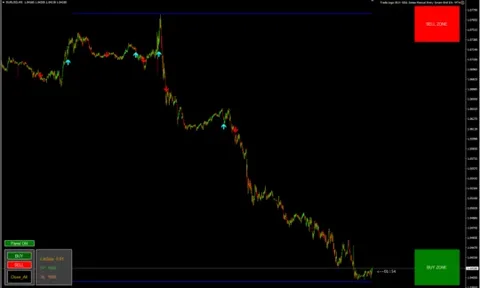MetaTrader 5, or MT5, is one of the most advanced trading platforms available today, with detailed tools for technical analysis, automated trading, and risk management. Another of its positives is hedging support, where multiple positions on the same security are opened in opposite directions. Hedging can be a useful risk management tool, particularly in those circumstances with the constraints that are characteristic of prop firm. These may include drawdowns, time limits, and strict risk management, which require developing a strategy not only aimed at profit but also capital preservation.
Learning Hedging in MT5
Hedging in MT5 allows a trader to open long and short positions on the same trading instrument without closing out each other. This is a very useful tool when there is high market volatility or when a trader wants to hedge risk without closing the initial position. For example, if a trader is in a long position and expecting a reversal on a short-term basis, they can open a short position without closing the initial one. The reason this is achievable is that the trader then has more freedom to move in reaction to changing market conditions, which can prove crucial when trading under strict trading rules that penalize high drawdowns or losses on a daily basis.
Why Hedging is Effective with Prop Firm Rules
Prop trading rules tend to concentrate on preserving capital, minimal drawdowns, and risk-adjusted profits. Hedging strategies are aligned with these principles by allowing the trader to manage floating losses more effectively. Instead of closing a losing trade prematurely, the trader can hedge the position, reducing exposure while waiting for a more profitable market condition. This strategy can help stay within drawdown limits and within the boundaries of trading parameters. Also, hedging offers the potential of locking gains or protecting profits without closing trades, offering an additional level of risk management, which is critical for clearing evaluation steps or maintaining funded accounts.
Strategy Framework
A solid hedging strategy on MT5 begins with a simple-to-comprehend market structure study on different timeframes. Traders will be required to outline significant support and resistance levels, trend lines, as well as reversal areas. The key idea is to take the initial position in the direction of the trend on the larger timeframe and hedge only when a firm counter-indicative signal is displayed on a smaller timeframe. As an example, a trader may go long on the daily trend but hedge with a short if the 15-minute time chart shows a bearish divergence. Positions need to be sized carefully, and stop-losses placed strategically to leave room for market movement without breaking firm trading limits.
Entry and Exit Rules
Precision in entries and exits is of the essence in hedging. A large position is to be entered only after confirmation by a minimum of two indicators or points of confluence (e.g., moving averages, Fibonacci retracement, or candlestick patterns). The hedge would be taken only if the market provides a genuine counter-trend signal. Both the trades must have fixed take-profit and stop-loss targets to avoid unmanaged floating drawdown. The traders will have to observe price action keenly after hedging and be ready to close either one or both the trades if the trend resumes or reverses convincingly. The objective is not to hold both simultaneously in the long run, since this could introduce margin inefficiencies and reduce profitability.
Risk Management
Effective risk management is the cornerstone of any trading plan, especially under the draconian rules of a prop trading setup. Risk is managed dynamically with hedging through adjustment of the position size and taking positions with high precision at opportune times. One of the recommended approaches is to risk no more than 0.5% to 1% per trade and limit the number of open positions so that overexposure does not take place. One must also monitor correlation between instruments, as hedging several positions on correlated pairs really compounds risk unintentionally. Monitoring equity and balance separately helps to manage both floating losses and locked-in profits better.
Trading Psychology
Hedging can be psychologically hard, as it can be bewildering or ambiguous to hold opposite positions. Traders need to be self-disciplined and trust their analysis instead of closing trades indiscriminately. Journaling, backtesting, and psychological preparation are required to establish confidence in the system. It is important to remember that hedging is not for avoiding loss but for managing risk, to try to eliminate emotional stress. Being emotionally detached, even as trades go both ways, is essential to be able to execute the strategy optimally and stay within the psychological demands of a stressful trading environment.
Using MT5 Tools as Hedging Tools
MT5 is equipped with several inbuilt tools that can be used to augment a hedging strategy. The depth of market (DOM) of the platform, multiple timeframes charted, one-click trading, and user-specific indicators are all helpful in selecting entry and exit points. Expert Advisors (EAs) can also be used by traders to automate parts of their strategy, e.g., entering into a hedge when a particular condition is met or dynamically trailing stop losses. MT5 reports and trade history help in performance tracking and refining the strategy with experience. Proper use of such utilities can provide an advantage, especially in cases where reliability and precision are preferred.
Final Thoughts
An MT5 hedge can be a good tool to ride out the risk-sensitive environment of prop trading. With sound market analysis, tight risk controls, and controlled trading, hedging can be utilized to protect capital without constraining responsiveness to markets in flux. For traders looking to implement this approach, starting with an MT5 download provides access to the platform’s full suite of tools designed for precision and flexibility. The secret is knowing when and how to hedge, and not to make it a knee-jerk reaction to market action. With experience, proper planning, and a methodical system, hedging is not just a defensive mechanism, but a strategic part of a sound trading system.







